A&P 2 Exam 1 - Hormones and Endocrine System
1/17
There's no tags or description
Looks like no tags are added yet.
Name | Mastery | Learn | Test | Matching | Spaced |
|---|
No study sessions yet.
18 Terms
Name the 4 different types of intercellular communication
Direct communication, paracrine communication, endocrine communication, synaptic communication
Describe direct communication
Uses gap junctions (connect cytoplasm directly), one cell to another cell.
Small things like ions, small solutes, and lipid-soluble materials can go through (sugars, amino acids)
Effects distributed to similar adjacent cells
Rare, highly specialized
Ex: cardiac myocytes (muscle cells)

Describe paracrine communication
Release paracrine factors through extracellular fluid (in the interstitial fluid, which is between cells)
Effects distributed to local area
Ex: blood clotting, inflammation

Describe endocrine communication
Hormones released by endocrine glands through the bloodstream
Effects distributed in target cells in other tissues and organs (far away distant cell)
Alters metabolic activities
Ex: pancreas releases insulin to process glucose

Describe synaptic communication
Happens across synapses
Neurons release neurotransmitters (out of synapse) into synaptic cleft
Effect distribution at specific areas (need appropriate receptors)
Crisis management
Ex: neuromuscular junction or neuron and a neuron
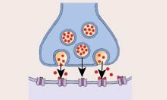
Name the three major classes of hormones
Monoamines, peptide hormones, and steroids
Characteristics of monoamines?
Made from amino acids (1 aa) which are converted into hormone
Come from tyrosine or tryptophan
Derivatives of tyrosine
Thyroid hormones (LIPID-SOLUBLE)
Catecholamines - epinephrine, norepinephrine, dopamine (all water-soluble)
Derivatives of tryptophan
Serotonin, melatonin (water-soluble)
Most water-soluble EXCEPT THYROID HORMONE
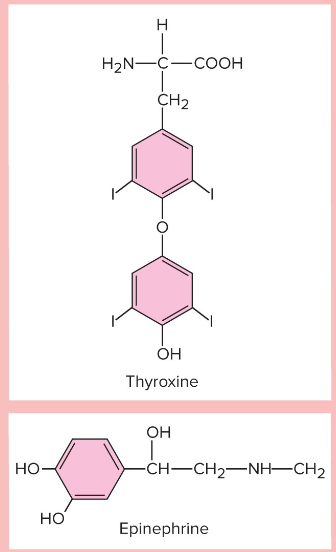
Characteristics of peptide hormones?
Made from chains of amino acids linked by peptide bonds
Synthesized through central dogma (DNA to RNA to protein) as pro-hormones (inactive to active)
3 types: glycoproteins, small proteins, short chain polypeptides
ALL water-soluble
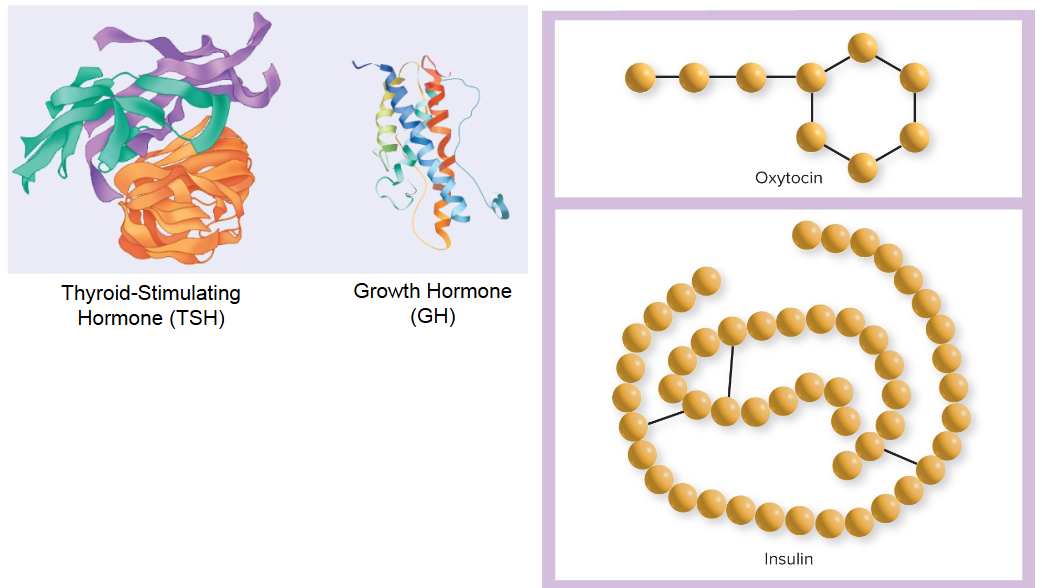
Describe the 3 types of peptide hormones?
Glycoproteins: huge (>200 aa), carbohydrate side chains. Ex: TSH, LH, FSH
Small proteins: 50-100 aa. Includes all hormones secreted by hypothalamus, heart, thymus, digestive tract pancreas, posterior lobe of pituitary gland. Basically most hormones. Ex: GH, PRL
Short chain polypeptides: very short (<50 aa). Ex: ADH, OXT
ALL water-soluble
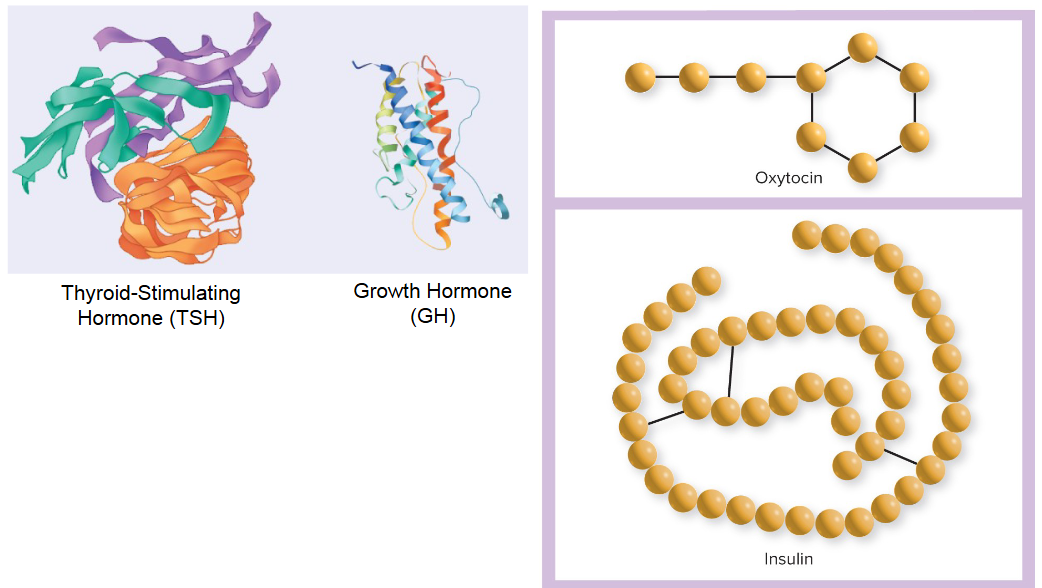
Characteristics of steroids?
Made from cholesterol
Released by
Reproductive organs (androgens, estrogens, progestins)
Adrenal glands (corticosteroids)
Kidneys (calcitriol)
ALL lipid-soluble
Because they are lipid-soluble and travel in blood (plasma contains water), they bind to transport (binding) proteins, like having a protein water-soluble coat to help them travel

Characteristics of paracrine factors?
Released into extracellular fluid (interstitial fluid) and act on nearby cells
Coordinate local cellular activities and affect enzymatic processes in extracellular fluid (interstitial fluid)
Ex: Histamine, nitric oxide (NO), catecholamines, eicosanoids
Eicosanoids - derived from arachidonic acid (big molecule, 20-carbon fatty acid)
Ex: prostaglandins, thromboxanes, prostacyclins, leukotrienes

How do free hormones circulate and act?
Molecules travel and freely dissolved in blood stream (plasma)
Fast acting: easily go through the kidney or liver and are processed
Enzymes, liver, kidneys will (easily) degrade the hormones in plasma or interstitial fluids
Functional <1 hour (short half-life)
Water-soluble
Monoamines, peptide
Since plasma membrane is a lipid barrier (water-soluble can’t get through), they use extracellular receptors (cell surface receptors)
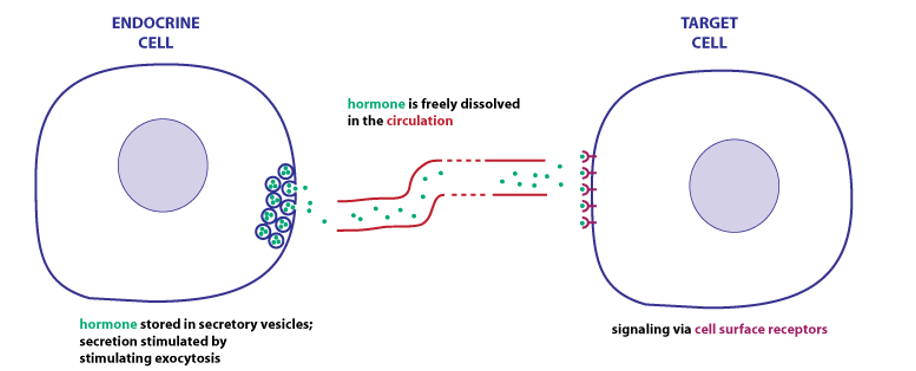
How do bound hormones circulate and act?
Bind to specialized transport proteins
Enzymes can’t get to them easily, not processed very well by liver and kidney
Remain in circulation longer >1 hour (days) (long half-life)
Bloodstream has a reserve of these hormones
Lipid-soluble
Steroids and thyroid hormone
They can leave plasma membrane easily because lipid-soluble and bind to binding proteins
Use intracellular receptors (nuclear receptors) (in cytoplasm and nucleus), interact with DNA (gene expression)
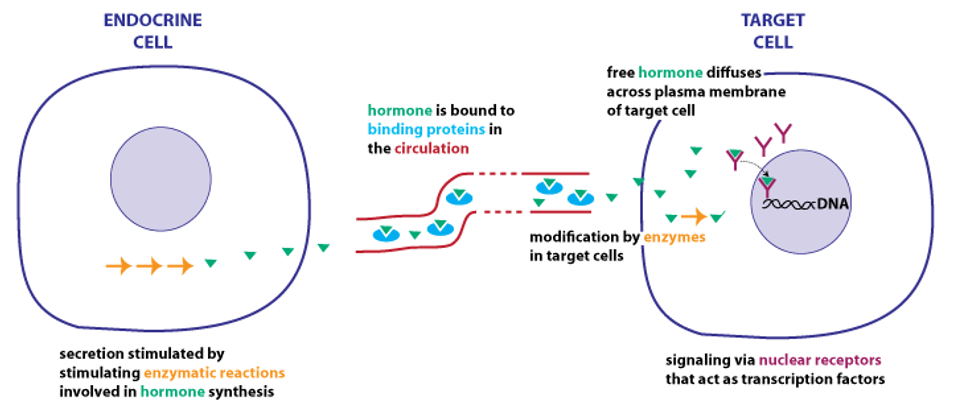
Summarize the characteristics of water-soluble molecules
High solubility in blood (because they can dissolve in water)
Quickly digested by enzymes in blood
Easily filtered by kidneys (leads to short half-life)
Short half-life (<1 hour)
No binding proteins
Peptide/protein hormones, monoamines
Summarize the characteristics of lipid-soluble molecules
Do not dissolve well in blood
Need binding proteins which allow them to be more water-soluble, which gives them long half-life
Long half-life (>1 hour-days)
Binding is specific (to hormone/molecule) and reversible (be able to let it go)
Steroids, eicosanoids (paracrine factors), thyroid hormone
Describe hormone receptors
How do extracellular (membrane-bound) receptors cause effects in a target cell?
Use different “signaling cascades” (pathways) to cause changes in cell function
Cyclic AMP (cAMP) Pathway
How do intracellular (nuclear) receptors cause effects in a target cell?